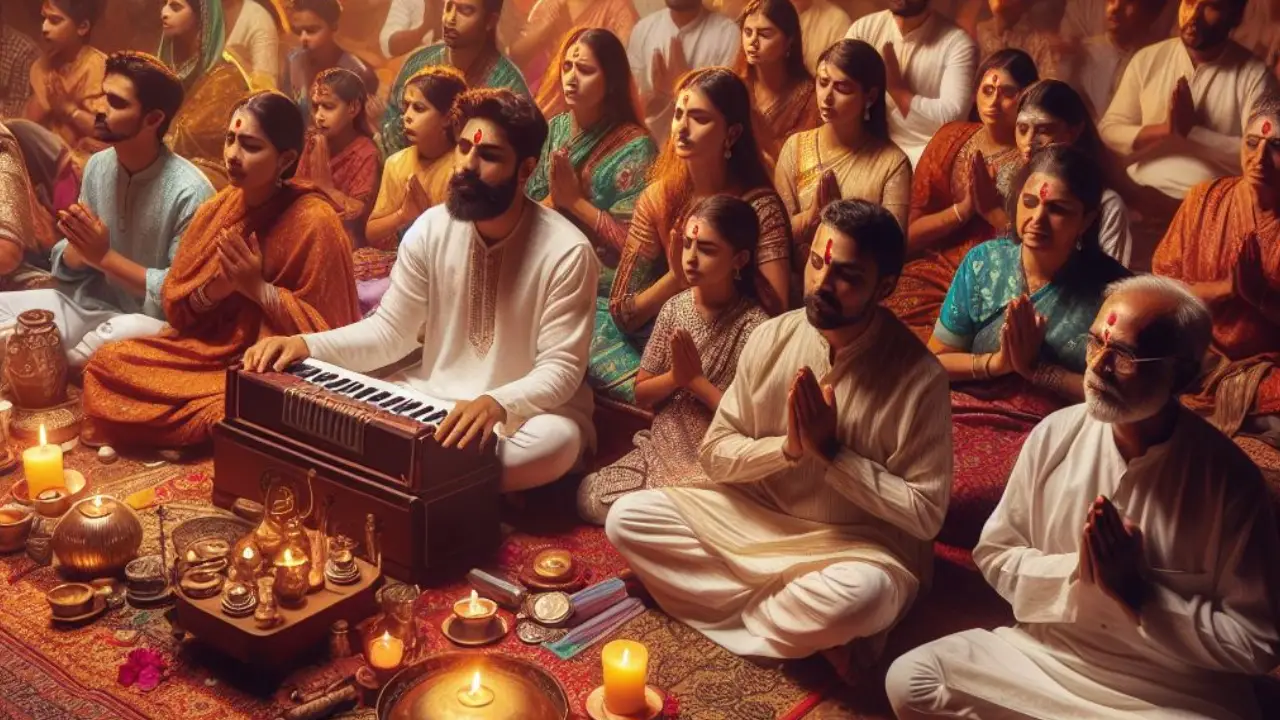Within the intricate fabric of Hinduism, music serves not merely as a source of entertainment but as a deep manifestation of spiritual expression. Two distinct musical traditions, Bhajan and Kirtan, play pivotal roles in connecting devotees with the divine.
Bhajan: A Melodious Devotion
Bhajan, originating from the Sanskrit word ‘bhaj,’ meaning to worship, is a devotional song that seeks to evoke a deep sense of connection with the divine. It is a personal and introspective musical journey that often involves a solo singer or a small group. The lyrics of Bhajans are typically poetic, expressing love, gratitude, and surrender to the divine.
In Hindu households, especially during religious ceremonies or festivals, the air is often filled with the soul-stirring tunes of Bhajans. The melodies vary, capturing the essence of different moods – from the serene to the ecstatic. The simple yet profound lyrics of Bhajans can touch the heart and elevate the spirit, creating a sacred ambiance.
Kirtan: The Joyous Communal Celebration
Kirtan, on the other hand, is a vibrant and communal expression of devotion. Rooted in the call-and-response tradition, it involves a lead singer or group chanting a mantra, and the congregation responding. This rhythmic exchange creates a powerful energy, fostering a sense of unity among the participants.
Kirtans are often held in temples, spiritual gatherings, or even in public spaces, where people from diverse backgrounds join together in harmony. The repetitive chanting of mantras has a meditative quality, allowing participants to transcend the mundane and connect with the divine on a profound level.
Imagine a crowded temple where people from various walks of life gather. The atmosphere is charged with the collective energy of devotion as the Kirtan begins. Voices blend, and for a moment, individual differences vanish, giving way to a shared spiritual experience.
The Spiritual Significance
Both Bhajan and Kirtan serve as pathways to spiritual realization in Hinduism. They are not mere musical performances but acts of worship that engage the mind, body, and soul. The repetitive nature of the chants in Kirtans, for instance, is believed to quiet the mind and bring about a state of inner peace.
Bhajans, with their emotive lyrics, act as a bridge between the devotee and the divine. They convey a range of emotions – from intense longing to joyous celebration – providing a holistic approach to spiritual expression. In the context of Hindu philosophy, these musical traditions are considered not just cultural practices but essential tools for self-realization.
The Role of Instruments
In both Bhajan and Kirtan, traditional Indian musical instruments play a crucial role in enhancing the spiritual experience. Instruments like the harmonium, tabla, and mridangam provide a rhythmic and melodic backdrop, creating a symphony of devotion. The harmonium, with its soulful tones, often leads the melody, guiding the participants through a journey of spiritual exploration.
Picture a serene ashram where a group gathers for an evening Bhajan session. The harmonium sets the tone, accompanied by the rhythmic beats of the tabla. As the music unfolds, the atmosphere becomes charged with a divine energy that transcends the physical realm.
Beyond Religious Boundaries
One of the remarkable aspects of Bhajan and Kirtan is their ability to transcend religious boundaries. While deeply rooted in Hindu traditions, these musical practices have gained popularity globally. Yoga studios, meditation centers, and spiritual retreats around the world often incorporate Bhajan and Kirtan as tools for mindfulness and spiritual growth.
The Transformative Power of Sound
In Hinduism, sound is not just a medium of artistic expression; it is a potent force with the ability to transform consciousness. The vibrations created through Bhajan and Kirtan are believed to resonate with the cosmic energy, aligning the individual with the universal rhythm.
Modern Expressions: Fusion and Innovation
While Bhajan and Kirtan have deep roots in tradition, contemporary musicians are exploring innovative ways to express these ancient practices. Fusion genres that blend traditional Indian music with modern elements are gaining popularity. This fusion not only attracts younger audiences but also breathes new life into these timeless traditions.
Imagine attending a concert where a modern musician seamlessly integrates electronic beats with the traditional tunes of a Bhajan. The audience, comprising both traditionalists and the younger generation, finds common ground in the fusion of old and new.
Join the Harmony
As we delve into the world of Bhajan and Kirtan, let’s not just observe but actively participate. Attend a local Kirtan session, try chanting a Bhajan, or explore the fusion of traditional and modern sounds. Share your experiences in the comments below. How has music enriched your spiritual journey? Your voice adds to the collective harmony!

